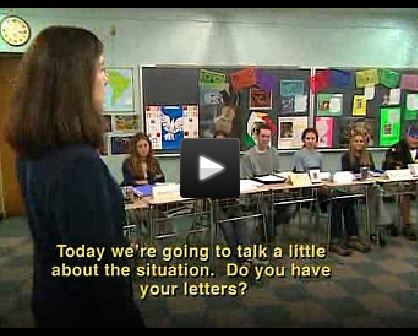|
|
A Sympathy Protest: Simulations and Role Play as a Vehicle for Language, Culture and Content in the Language Classroom
Simulations and role plays can be used to great effect in the World Language classroom. Students can take on the roles of characters in a historical event, a work of literature, or any story and, by taking on new identities, they can delve more deeply into diverse cultural perspectives. Accompanied by real-world tasks and critical thinking activities, simulations can be engaging, pedagogically sound, and fun! Below is information about one classroom simulation for intermediate Spanish students called "The Politics of Art - A Sympathy Protest." Included are resources for designing and developing a simulation or role play for your own classroom.
|
|
 |
Resources for the "Politics of Art/Sympathy Protest" lesson
 |
|
Watch the video: In this lesson called “The Politics of Art,” students researched a contemporary Latin visual artist online, sent an email to the artist, and then took on the persona of the artist in a role-play exhibition of their art. The class then read and discussed a letter written by Colombian artists and intellectuals protesting recent changes in European immigration policies that required Colombians to acquire a visa to travel to Spain. Next students were told that they were members of a fictitious group, “Cooperativa de Artistas Panamericanos” that was invited to show their work at a major exhibition in Spain. Students discussed and debated the topic and formed small groups based on whether they sympathized or not with the Colombian protesters. After debating all points, students decided that the Cooperative would boycott the Spanish exhibition in support of the Colombian protest. As a culminating activity, students wrote a new letter to the Spanish government to explain and support their reasoning for their boycott. |
- PowerPoint: "A Sympathy Protest: Simulations and Role Play as a Vehicle for Language, Culture, and Content in the World Language Classroom": An overview about how to use role play and simulations in the language classroom, including specific examples of activities for both French and Spanish classes.
- Video series website: View more information about the class, questions for consideration, and links to standards on the Annenberg website: "Teaching Foreign Languages: A Library of Classroom Practices."
- Article: "A Sympathy Protest: Products, Practices, and Perspectives in a Language Classroom," (co-authored with A. Stryker), Hispania, Vol. 89, No. 1 (Mar., 2006), pp. 103-109.
- Class website: "A Sympathy Protest" - although no longer active, this pdf shows some of the student materials, the artists they chose to represent, and the letter the class ultimately wrote at the end of the simulation to explain their decision not to travel to Spain in order to support the Colombian protest.
- Newspaper article: "Intelectuales colombianos, contra la política migratoria de España: García Márquez, Fernando Botero y Alvaro Mutis, entre otros, no volverán a la península Ibérica" (published in El País, March 22, 2001).
- The letter: written by Gabriel Garcia Marquez, Fernando Botero, and others: "Carta abierta de los intelectuales españoles al gobierno de España en relación con la exigencia de un visado a los ciudadanos de Colombia" (published in El País March 23, 2001).
- Class website: "The Politics of Latin America" - This page is another example of a class project in which students were involved in a role-play to simulate the formation of political parties in Latin America. After viewing the Argentine film "No Habrá Más Pena Ni Olvido", students studied Juan Domingo Perón and his political ideas. As a culminating project, students formed three political parties of their own and developed platforms to express their beliefs and ideas.
Using Simulations and Role Plays in the Language Classroom
- Article: " 'The Play's the Thing' - Suspension of disbelief and simulation as a Means of Connecting to Global Communities," from Language Magazine, Vol. 10, No. 4, November 2014.
- Article: "Simulations - A Tool for Testing 'Virtual Reality' in the Language Classroom," from the journal On JALT "95: Curriculum and Evaluation. (1996). Tokyo: The Japan Association for Language Teaching, pp. 313-317.
- Article: "Simulation/gaming and the acquisition of communicative competence in another language," from Simulation and Gaming - an Interdisciplinary Journal of Theory, Practice, and Research, Vol. 32 No. 4, December 2001 481-491.
- Article: "Role Play in Teaching Culture: Six Quick Steps for Classroom Implementation," good tips and resources for incorporating role play into the language classroom.
- eBook: "Exploiting Internet Case Studies and Simulation Templates for Language Teaching and Learning," (especially Chapter 2: "Global Simulation Projects in Language Teaching).
- Training module: "Teaching with Simulations: A teacher-training module with a video, a rationale for using simulations in education, sample simulation activities, and references.
- Blogpost: "Use simulations to help students learn," with links to examples and a concise rationale
- Article: "An Introduction to Simulations for Teaching and Learning" about computer-based simulations from Columbia University's Office of New Media Tools and Resources.
- Resources: "Fantasy trips in the language classroom" - materials, suggestions, and information about taking a virtual trip with K-12 students of languages at all levels.
|